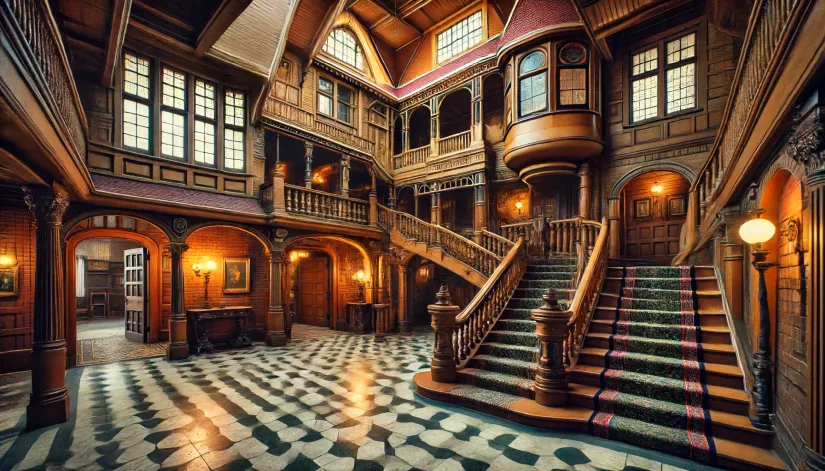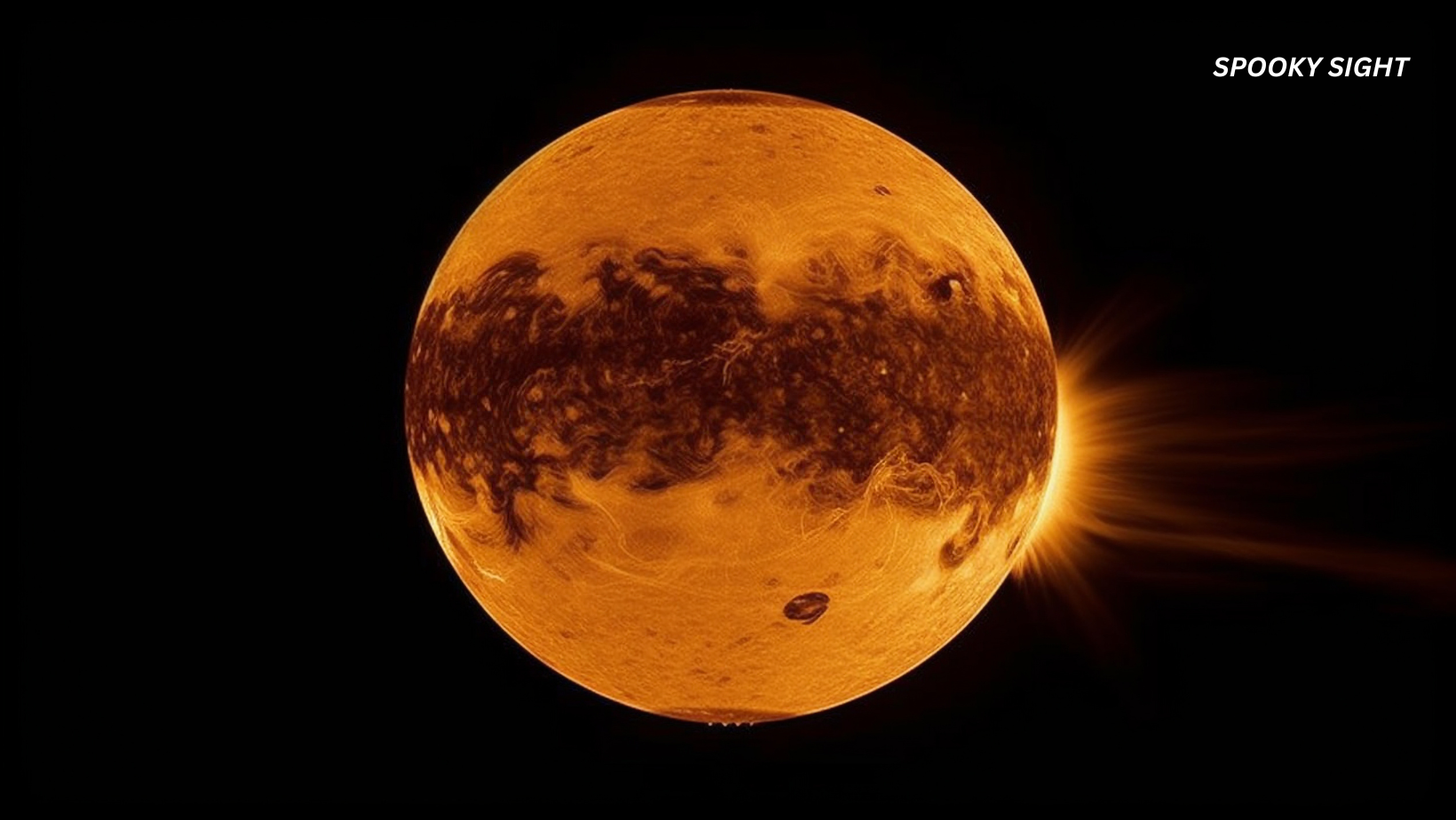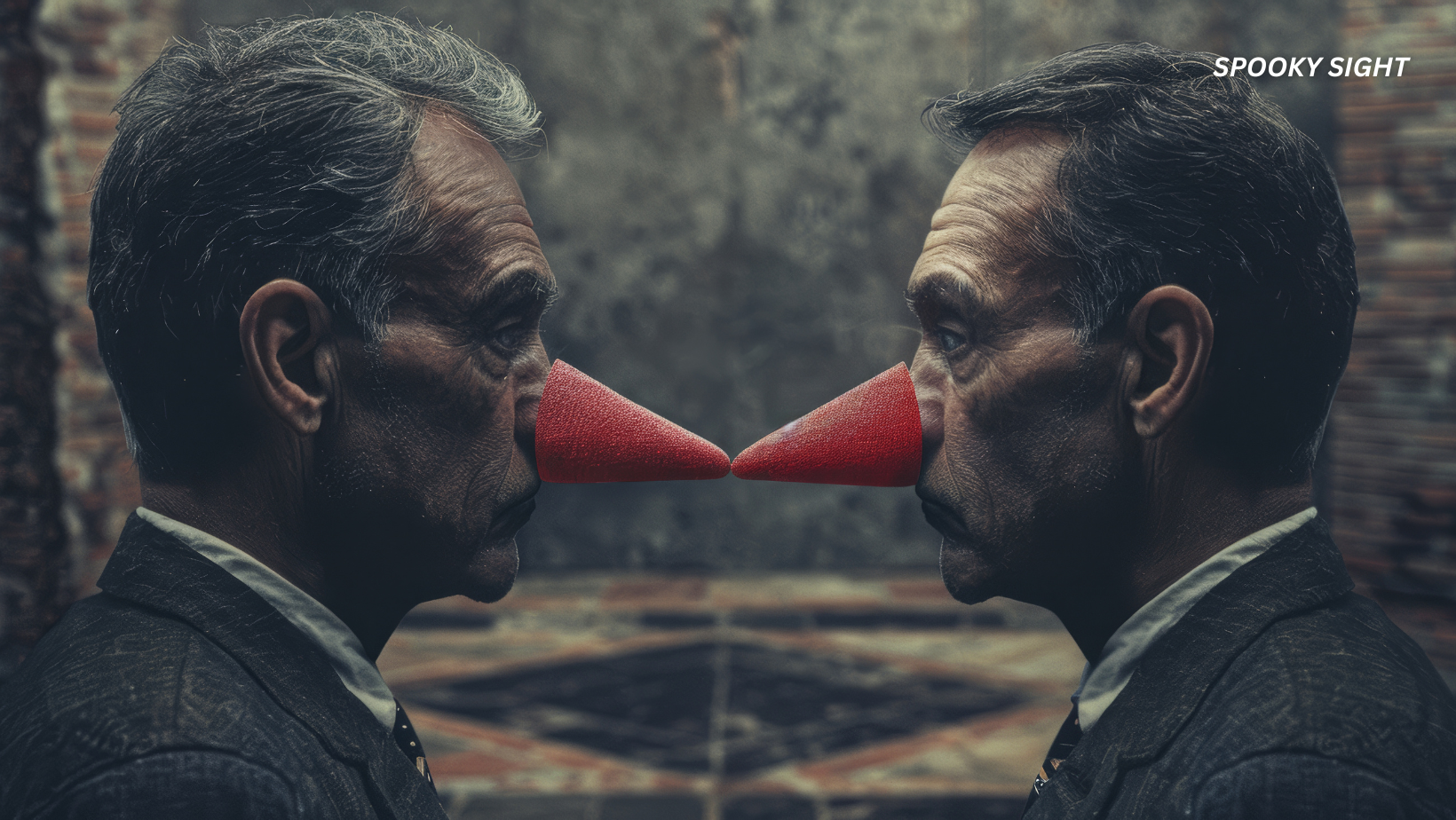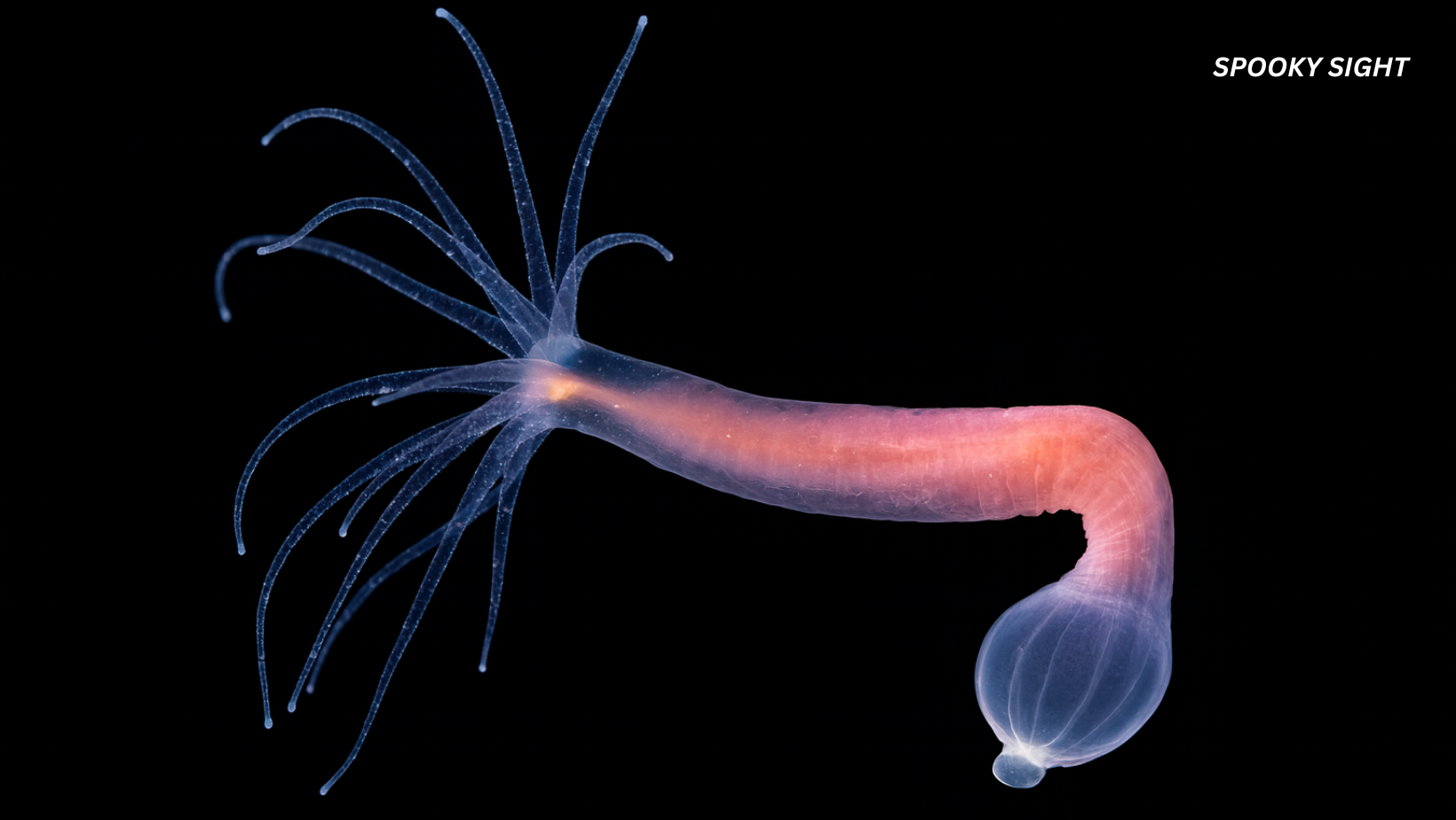The Winchester Mystery House in San Jose, California, is a fascinating Victorian mansion renowned for its unusual architecture and rumored hauntings.
But why exactly are there so many stories about the strange phenomena that happened (or still happen) here?
Well, the house’s eerie reputation is largely due to the many workers who died there under suspicious circumstances or in bizarre accidents.
In time, all these tragic and mysterious deaths lead to rumors of the house being cursed—or even haunted.
In this article:
What is the Winchester Mystery House?
The Winchester Mystery House is a massive mansion in San Jose, California. It once served as the personal residence of Sarah Winchester—the widow of firearms magnate William Wirt Winchester.
After the deaths of her husband and infant daughter, Sarah Winchester moved to California.
She continued building the house from 1886 until her death in 1922.
Today, the mansion is a well-known tourist attraction, drawing millions of visitors since opening for tours in 1923.
People visit the Winchester Mystery House for its peculiar design, which features a fixation with the number 13 and other architectural oddities.
Architectural oddities? Well, yes. So many in fact that we dedicated an entire article on some of the most incredible facts about the Winchester Mystery House.
The entire mansion was constructed without a plan, sketch, or architectural vision. Basically, the house is an incoherent sequence of rooms and labyrinthine hallways.
Staircases leading nowhere, doors that open onto brick walls, and windows overlooking other rooms were among the house’s many peculiar features.
But what ‘inspired’ Sarah Winchester to build such a monstrous place? According to some, her motivation was linked to spiritualism.
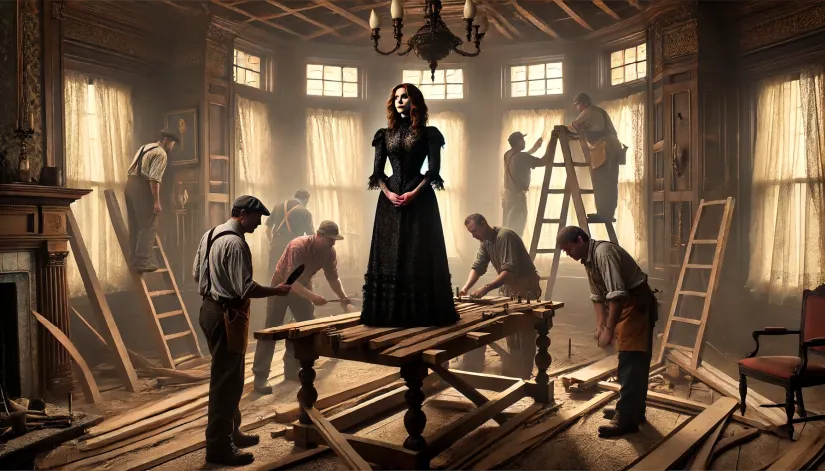
The Construction Begins
In 1884, Sarah Winchester bought an unfinished farmhouse in the Santa Clara Valley. Originally known as Llanada Villa, the farm was two stories high, had eight rooms, and was situated on 40 acres of land.
Sarah Winchester’s ownership of the farmhouse marked the beginning of a remarkable property transformation as the widow launched a ceaseless construction project that would continue until her death in 1922.
She enlisted an army of carpenters, craftsmen, and laborers to work around the clock, transforming the modest eight-room farmhouse into a sprawling mansion with hundreds of rooms.
The work was relentless, with reports suggesting that construction proceeded 24/7 (a remarkable feat facilitated by the mansion’s own gas plant, which helped illuminate nighttime construction activities).
Architectural Wonders and Oddities
As mentioned before, the Winchester Mystery House is an architectural marvel full of peculiar features and oddities that continue to baffle and fascinate visitors.
It blends elements from the Second Empire architectural style, Queen Anne revival style, and Carpenter Gothic into a singular, mesmerizing edifice.
This fusion is evident in the mansion’s distinctive features, such as its Mansard roof, an emblem of the Second Empire style, known for its steep slope and ornate details.
The house’s bay windows, another hallmark of its eclectic style, afford glimpses into the intricate world Sarah Winchester created.
At the same time, the widow’s walk—a feature associated with the Carpenter Gothic tradition—hints at the melancholy and isolation that marked her life.

Staircases to Nowhere
One of the most famous oddities in the Winchester Mystery House is its staircases that lead to nowhere.
These staircases often end abruptly at ceilings or walls, contributing to the labyrinth-like design of the mansion.
SpookySight recommends: Who Is Resurrection Mary, Chicago’s Most Haunting Ghost?
One theory suggests that these bizarre features were designed to confuse or deter the spirits believed to be haunting Sarah Winchester.
Doors to Nowhere
Similarly, there are doors that open to blank walls or lead to significant drops. For instance, one door on the second floor opens outward to a sheer drop into the garden below.
Windows and Skylights
The mansion includes numerous windows and skylights in unusual places. Some windows are set into the floors, and there are even interior windows that look from one room into another, creating a dizzying effect.
Some rumors suggest Sarah was instructed by one (or more) mediums to do whatever was necessary to appease the restless spirits of those killed by Winchester rifles.
In fact, the stained-glass windows featuring Winchester rifle designs appear to constantly remind visitors of the source of Sarah’s fortune and her attempts to reconcile with its consequences.
The Number 13
Sarah Winchester was obsessed with the number 13—which is evident throughout the Winchester Mystery House.
This fascination is woven into the fabric of the mansion’s design, showcasing her belief in numerology and its supposed protective powers against the spirits she thought haunted her:
- 13-Paned Windows: Many windows throughout the house feature 13 panes of glass, including those in prominent rooms like the Daisy Bedroom and various hallways.
- 13-Panel Ceilings: Ceilings in several rooms are constructed with 13 panels.
- 13 Bathrooms: The mansion has 13 bathrooms, each intricately designed to incorporate this number. Notably, the 13th bathroom itself has 13 windows.
- 13-Step Stairways: Some staircases are designed with exactly 13 steps.
- 13 Coat Hooks: In the Séance Room (see below), there are 13 coat hooks.
- 13 Drain Holes: Custom sinks with 13 drain holes (see the Hall of Fires below).
- Stained Glass Windows: Sarah designed some stained glass windows with 13 colored stones or 13 elements.
Did you know?
In honor of Sarah’s fascination, the Winchester Mystery House celebrates every Friday the 13th by ringing the mansion’s bell 13 times at 1:13 PM (13:13 in military time).
Trap Doors and Secret Passages
The mansion is riddled with numerous trap doors and secret passages, which Sarah Winchester purportedly used to move around undetected and escape from any spirits that might be following her.
Secret passages wind through the mansion, connecting various rooms in unexpected ways. Many passages are cleverly concealed, accessible only through hidden panels or behind false walls.
Tiny Stairs and Low Risers
Another unique feature is the “easy riser” stairs, which are designed with very short steps (often only a few inches high). Now, unlike other oddities in the Winchester Mystery House, the “easy riser” stairs actually served a purpose.
Sarah Winchester suffered from severe arthritis in her later years. This practical stairs design allowed her to move between floors without putting too much strain on her joints.
Similarly, the “low riser” stairs also served a functional purpose. These staircases often zigzag back and forth, taking up more horizontal space than typical stairs but providing a gentle incline.
Elevators and Modern Conveniences
Despite its age, the Winchester Mystery House was equipped with modern conveniences for its time, including three elevators, forced-air heating, and indoor plumbing.
Disorienting Layout
The overall layout of the house is designed to disorient. With 160 rooms, 40 staircases, and numerous winding hallways, it’s easy to get lost.
A Collection of Bizzare and Unusual Rooms
It’s no secret that the Winchester Mystery House is full of strange rooms, and no one can really explain why they are there.
But some are even more unusual than others.
These ‘unique’ rooms, each with its own history and peculiarities, add to the allure and mystery of the Winchester Mystery House, making it a fascinating destination for those intrigued by its eccentric architecture and rumored paranormal activity.
Some of the most notable rooms include:
The Grand Ballroom
The Grand Ballroom is arguably one of the most breathtaking spaces in the Winchester Mystery House.
Built with the finest materials available at the time and at a great expense, this room showcases the opulence and grandeur of the era. It cost over $9,000 to construct (which was more than three times the cost of an average home in the late 1800s).
Rumor has it that the design of this grand room inspired the ballroom in Disney’s Haunted Mansion ride.
The ballroom is known for its intricate woodwork, expansive crystal windows, and elaborate furnishings. One of its unique features is the Shakespearean-inscribed stained-glass windows, quoting from “Troilus and Cressida” and “Richard II.”
It’s also rumored that Sarah Winchester loved to play the pump organ in the Grand Ballroom, contributing to the house’s eerie atmosphere.
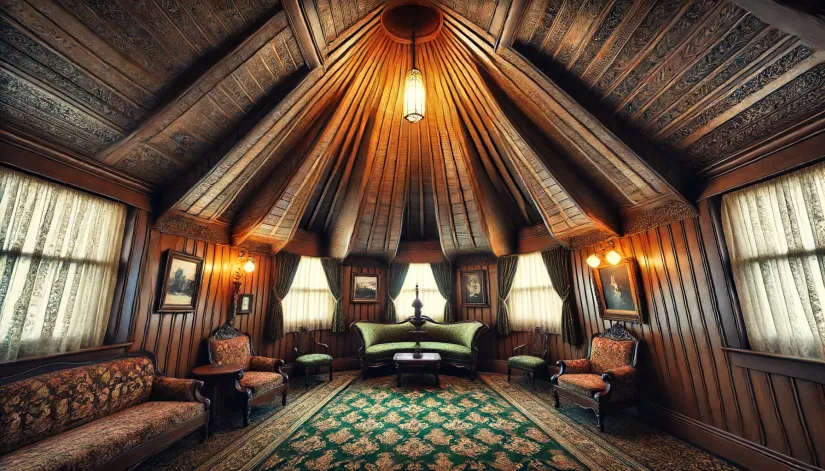
The Witches Cap
One of the most intriguing rooms in the Winchester Mystery House is the Witch’s Cap (named for its peculiar conical shape that looks just like a witch’s hat).
This room is famous for its strange, eerie vibe and is a hot spot for spooky stories and paranormal activity. In fact, some say the room’s shape was intended to ward off spirits.
Visitors often report feeling an unsettling presence and unusual temperature changes when they step inside. The room’s unique acoustics are also particularly fascinating—when you stand in the center and speak, your voice seems to surround you, creating an eerie effect.
Its unique architecture, with walls that seem to converge towards the peak, and the legends of ghostly encounters make it a must-see if you ever decide to visit the Mystery House.
A notable historical tidbit is that in 1924, the famous magician Harry Houdini allegedly held a séance in the Witch’s Cap room during a midnight tour of the house.
The Twin Dining Rooms
While we can’t know for sure, many think the Twin Dining Rooms are part of the original farmhouse Sarah Winchester bought when she first arrived in San Jose.
Why even have twin dining rooms? Well, no one knows for sure. These rooms are just another addition to the house’s maze-like layout.
Over the past few years, significant restoration efforts have brought these rooms back to life.
Interestingly, during the renovations, hidden behind the walls, preservationists found a perfectly preserved strip of the original wallpaper, featuring vibrant green, black, red, and gold floral designs.
Furthermore, during the restoration of the North Dining Room, a hidden pocket door and a boarded-up trap door in the ceiling were uncovered, likely intended as a light shaft extending to the third floor.
Did you know?
The Winchester Mystery House features a window designed by Tiffany & Co. that creates a beautiful prismatic rainbow effect when sunlight passes through it. However, it was installed in an interior room with no access to light, rendering its intended effect invisible.
Sarah Winchester’s Bedroom
One of the most personal spaces in the Winchester Mystery House is Sarah Winchester’s Bedroom, where she spent her final moments in 1922.
This room has been carefully preserved to maintain its original details, offering a glimpse into Sarah Winchester’s private life.
Notably, the room features the original Lincrusta Walton wallcovering and ornate ceilings that have remained intact for nearly a century.
Sarah relocated to this bedroom after getting trapped in the Daisy Bedroom during the 1906 earthquake—a significant event that led her to believe the spirits were sending her a message.
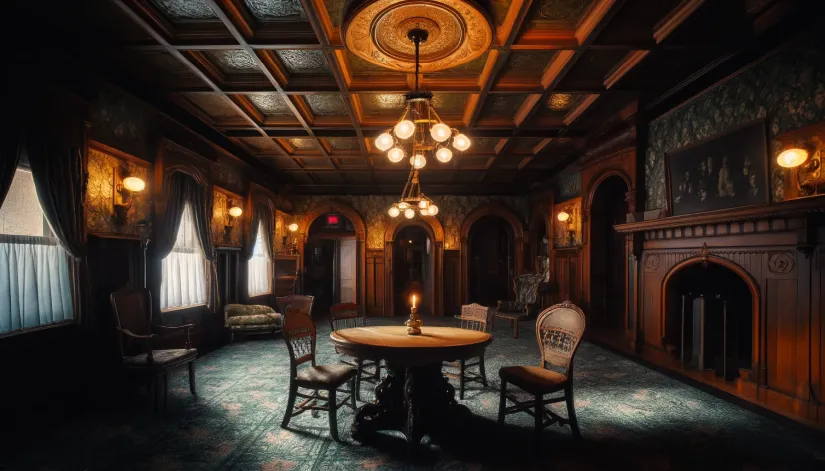
The Séance Room
At the heart of the mansion’s mystique lies the Séance Room. The room has only one entrance but three exits, including one that leads to a ten-foot drop into the kitchen below. Another exit is disguised as a closet.
Legend has it that Sarah conducted nightly séances here, always at midnight, summoning spirits with the toll of a bell. Another bell at 2 AM would signal the spirits to leave.
This room was a central point for Sarah. There, she believed she received architectural advice from good spirits, which could explain the house’s bizarre features, like stairs to nowhere and doors opening into walls.
Sarah’s fascination with the number 13 is evident in this room, too—13 coat hooks, aligning with the numerous other instances of the number throughout the mansion.
The Daisy Bedroom
The Daisy Bedroom in the Winchester Mystery House is not just any ordinary room; it holds a significant place in the mansion’s eerie history.
The Daisy Bedroom, named for its floral motifs, was where Sarah Winchester was trapped during the 1906 San Francisco earthquake.
Many historians believe this exact event marked a turning point in her life, reinforcing her belief that the spirits were unhappy with her and prompting her to seal off the front of the house, leaving the damaged parts unrepaired.
This room is rich in Victorian details: ornate ceilings, intricate woodwork, and beautiful stained-glass windows that filter the sunlight into a kaleidoscope of colors.
With its heavy wooden frame, the bed adds to the room’s vintage charm, making it feel like a step back in time.
But the Daisy Bedroom is not just fascinating because of its decor. It’s also fascinating because of the stories that surround it. And—another thing worth mentioning—this is one of Winchester Mystery House’s most haunted rooms. Allegedly.
Visitors often report feeling a chill when they step into the Daisy Bedroom; some even claim to have sensed a presence watching them.
The Hall of Fires
The Hall of Fires earned its name due to the many fireplaces—four.
The room is also associated with a lot of paranormal activity. In fact, many visitors (and staff members) reported ghostly encounters here.
For instance, during a restoration project, a worker on a ladder felt an unexpected tap on his shoulder.
When he turned around, no one was there. Moments later, he felt a firm push on his back, prompting him to leave the room immediately.
The room also features a sink with 13 overflow drain holes.
The Basement
The Basement is a subterranean area that played an important role in the house’s day-to-day operations. It is now a highlight of the “Explore More Tour” (which explores parts of the mansion that are usually off-limits to visitors).
As with many other rooms, the Basement is also allegedly haunted—by a ghostly figure known as Clyde.
Clyde has been spotted multiple times by staff and visitors alike. Witnesses described him as a man wearing a mustache, white overalls, and a Victorian boater hat.
He is often seen pushing a wheelbarrow or attempting to repair the fireplace. His spectral presence has become a well-known story among the Winchester Mystery House’s ghost legends.
The Basement also housed the estate’s original gas manufacturing plant, which provided the mansion with modern amenities such as gas lighting and steam heating—remarkable features for a house built in the late 19th and early 20th centuries.
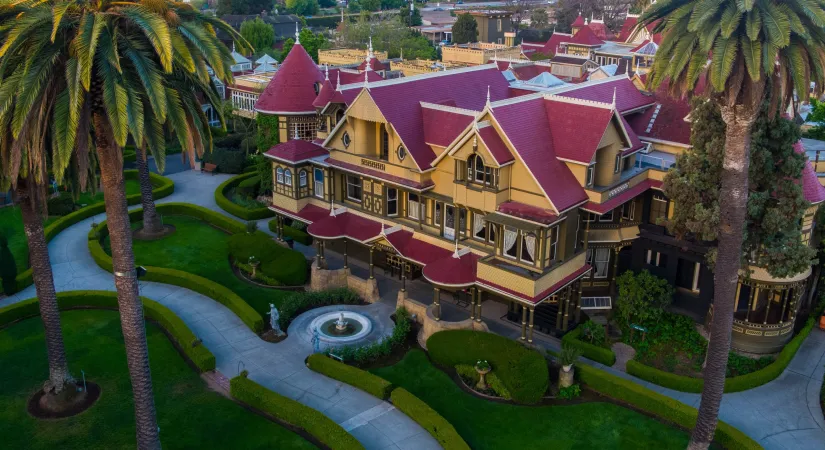
Winchester Mystery Mansion Today
In 1922, the Winchester estate covered approximately 162 acres, including the Winchester House, outbuildings, gardens, and land. Today, the property consists of just the main building and a few outbuildings, totaling about 4.5 acres.
In 2016, the Winchester House was declared a “historical monument,” becoming one of California’s most significant tourist attractions.
But is the Winchester House truly haunted? We don’t know. Unfortunately, during our visit, we didn’t experience anything out of the ordinary. However, strange events have been reported in recent years.
Whether it’s a clever marketing strategy or the Winchester estate is indeed a paranormal hotspot, one thing is sure: the mansion is one of a kind.
Frequently Asked Questions
How many rooms does the Winchester Mystery House have?
The Winchester mansion has an astonishing 160 rooms, including 40 bedrooms, 40 staircases, 13 bathrooms, 6 kitchens, and numerous other unique spaces.
Why does the Winchester House have so many rooms?
The expansive and continuous construction of the Winchester House is believed to be driven by Sarah Winchester’s attempt to appease the spirits of those killed by Winchester rifles.
Guided by a medium, Sarah was advised that she would be safe from these spirits as long as she kept building. This resulted in the house’s never-ending construction, leading to its sprawling design with numerous rooms and odd architectural features.
How many floors are in the Winchester House?
The Winchester Mystery House originally had seven stories, but after the 1906 San Francisco earthquake, it was reduced to four floors.
Does anyone live in Winchester House?
No, no one currently lives in the Winchester Mystery House. It has been a public tourist attraction since 1923, nine months after Sarah Winchester’s death. The house is maintained for historical tours and special events.
How old is the Winchester House?
Construction on the Winchester House began in 1886 and continued uninterrupted until Sarah Winchester’s death in 1922. This means the house is now over 130 years old.
How big is the real Winchester house?
The Winchester Mystery House originally covered a 162-acre estate, but today, it sits on a more modest 4.5 acres. The main mansion itself is approximately 24,000 square feet.

